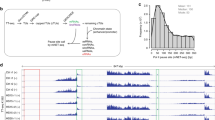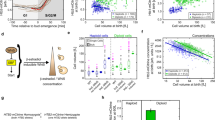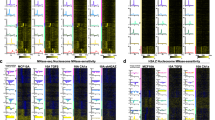Abstract
Knowledge of how genes are regulated during the cell cycle is essential for understanding the process of cell growth on a molecular level. Numerous studies have established that, as mammalian cells go through the cell cycle, histone mRNA levels change, the largest amount being produced in the S phase1–7. Both tran-scriptional and post-transcriptional mechanisms are responsible for this regulation and it has recently been demonstrated that nucleotide sequences in both the 5′ and 3′ termini of the histone gene are involved8–10. From deletion analysis of a hamster H3.2 fusion gene, we report here that the crucial control signals for both cell-cycle regulation and high level expression in vivo are contained in a 32-nucleotide (nt) region about 150 nt upstream of the TATA sequence and do not require any histone protein coding sequence. By comparison, the promoter of the herpes simplex virus (HSV) thymidine kinase gene is serum-stimulated but not cell-cycle regulated. The cell-cycle control exerted by the histone DNA regulatory element acts at the transcriptional level, as the rate of transcription is stimulated during the DNA synthetic phase of the cell cycle. Using DNA–protein mobility shift experiments, we demonstrate the existence of high affinity cellular factors interacting with the histone H3.2 promoter sequence. The concentration of the protein–DNA complexes shows cell-cycle variation, particularly during the transition from late G1 to the DNA synthesis phase. These data provide evidence for in vivo interactions between the cell-cycle transcriptional regulatory factors and the cis-acting DNA domain.
This is a preview of subscription content, access via your institution
Access options
Subscribe to this journal
Receive 51 print issues and online access
$199.00 per year
only $3.90 per issue
Buy this article
- Purchase on Springer Link
- Instant access to full article PDF
Prices may be subject to local taxes which are calculated during checkout
Similar content being viewed by others
References
1. Schumperli, D. Cell 45, 471–472 (1986). 2. Plumb, M., Stein, J. & Stein, G. Nucleic Acids Res. 11, 2391–2410 (1983). 3. Sittman, D. B., Graves, R. A. & Marzluff, W. F. Proc. natn. Acad. Sci. U.S.A. 80, 1849–1853 (1983). 4. Heintz, N., Sive, H. L. & Roeder, R. G. Molec. cell. Biol. 3, 539–550 (1983). 5. DeLisle, A. J., Graves, R. A., Marzluff, W. F. & Johnson, L. F. Molec. cell. Biol. 3, 1920–1929 (1983). 6. Alterman, R.–B. M. et al. Molec. cell. Biol. 4, 123–132 (1984). 7. Artishevsky, A., Delegeane, A. M. & Lee, A. S. Molec. cell. Biol. 4, 2364–2369 (1984). 8. Artishevsky, A., Grafsky, A. & Lee, A. S. Science 230, 1061–1063 (1985). 9. Liischer, B., Stauber, C., Schindler, R. & Schumperli, D. Proc. natn. Acad. Sci. U.S.A. 82, 4389–4399 (1985). 10. Stauber, C., Luscher, B., Eckner, R., Lotscher, E. & Schumperli, D. EMBO J. 5, 3297–3303 (1986). 11. Kadonaga, J. T., Jones, K. A. & Tjian, R. Trends biochem. Sci. 11, 20–23 (1986). 12. Hanley, S. M., Bleecker, G. C. & Heintz, N. Molec. cell. Biol. 5, 380–389 (1985). 13. Sive, H. L., Heintz, N. & Roeder, R. G. Molec. cell. Biol. 6, 3329–3340 (1986). 14. Clerc, R. G., Bucher, P., Strub, K. & Birnstiel, M. L. Nucleic Acids Res. 11, 8641–8657 (1983). 15. Taylor, D., Wellman, S. E. & Marzluff, W. F. Molec. Evol. 23, 242–249 (1986). 16. Davis, J. & Smith, D. I. A. Rev. Microbiol. 32, 469–518 (1978). 17. Melero, J. A. J. cell. Physiol. 98, 17–30 (1979). 18. Delegeane, A. M. & Lee, A. S. Science 215, 79–81 (1982). 19. Wang, M.–L. J. & Lee, A. S. Biochem. biophys. Res. Commun. 110, 593–601 (1983). 20. Mulligan, R. C. & Berg, P. Proc. natn. Acad. Sci. U.S.A. 78, 2072–2076 (1981). 21. Dulbecco, R. Nature 227, 802–806 (1970). 22. Melero, J. A. & Fincham, V. J. cell. Physiol. 95, 295–306 (1978). 23. Ashihara, J., Cheng, S. D. & Baserga, R. J. cell. Physiol. 96, 365–369 (1978). 24. Lin, A. Y., Chang, S. C. & Lee, A. S. Molec. cell. Biol. 6, 1235–1243 (1986). 25. Attenello, J. W. & Lee, A. S. Science 226, 187–190 (1984). 26. Osley, M. A., Gould, J., Kirn, S., Kane, M. & Hereford, L. Cell 45, 537–544 (1986). 27. Nasmyth, K. Cell 42, 225–235 (1985). 28. Capusso, O. & Heintz, N. Proc. natn. Acad. Sci. U.S.A. 82, 5622–5626 (1985). 29. Alterman, R.–B. M., Sprecher, C., Graves, R., Marzluff, W. F. & Skoultchi, A. I. Molec. cell. Biol. 5, 2316–2324 (1985). 30. Fried, M. G. & Crothers, D. M. J. molec. Biol. 172, 241–262, 263–282 (1984). 31. Singh, H., Sen, R., Baltimore, D. & Sharp, P. A. Nature 319, 154–158 (1986). 32. Sive, H. L. & Roeder, R. G. Proc. natn. Acad. Sci. U.S.A. 83, 6382–6386 (1986). 33. Sanger, F., Nicklen, S. & Coulson, A. K. Proc. natn. Acad. Sci. U.S.A. 74, 5463–5467 (1977). 34. Guidelines for Quick and Simple Plasmid Sequencing (Boehringer Mannheim, 1986). 35. Lee, A. S., Delegeane, A. M., Baker, V. & Chen, P. C. /. biol. Chem. 258, 597–603 (1983). 36. Manley, J. L., Fire, A., Cano, A., Sharp, P. A. & Gefter, M. L. Proc. natn. Acad. Sci. U.S.A. 77, 3855–3859 (1980). 37. Strauss, F. & Varshavsky, A. Cell 37, 889–901 (1984).
Author information
Authors and Affiliations
Rights and permissions
About this article
Cite this article
Artishevsky, A., Wooden, S., Sharma, A. et al. Cell-cycle regulatory sequences in a hamster histone promoter and their interactions with cellular factors. Nature 328, 823–827 (1987). https://doi.org/10.1038/328823a0
Received:
Accepted:
Issue Date:
DOI: https://doi.org/10.1038/328823a0
This article is cited by
-
Multilayered chromatin analysis reveals E2f, Smad and Zfx as transcriptional regulators of histones
Nature Structural & Molecular Biology (2013)
-
Proximal promoter region of the wheat histone H3 gene confers S phase-specific gene expression in transformed rice cells
Plant Molecular Biology (1993)
-
Coordination of expression of DNA synthesis genes in budding yeast by a cell-cycle regulated trans factor
Nature (1991)
-
Steady-state and nuclear run-on analyses of transcription in a temperature-sensitive Chinese hamster cell mutant with a defect in RNA metabolism
Somatic Cell and Molecular Genetics (1988)
Comments
By submitting a comment you agree to abide by our Terms and Community Guidelines. If you find something abusive or that does not comply with our terms or guidelines please flag it as inappropriate.



